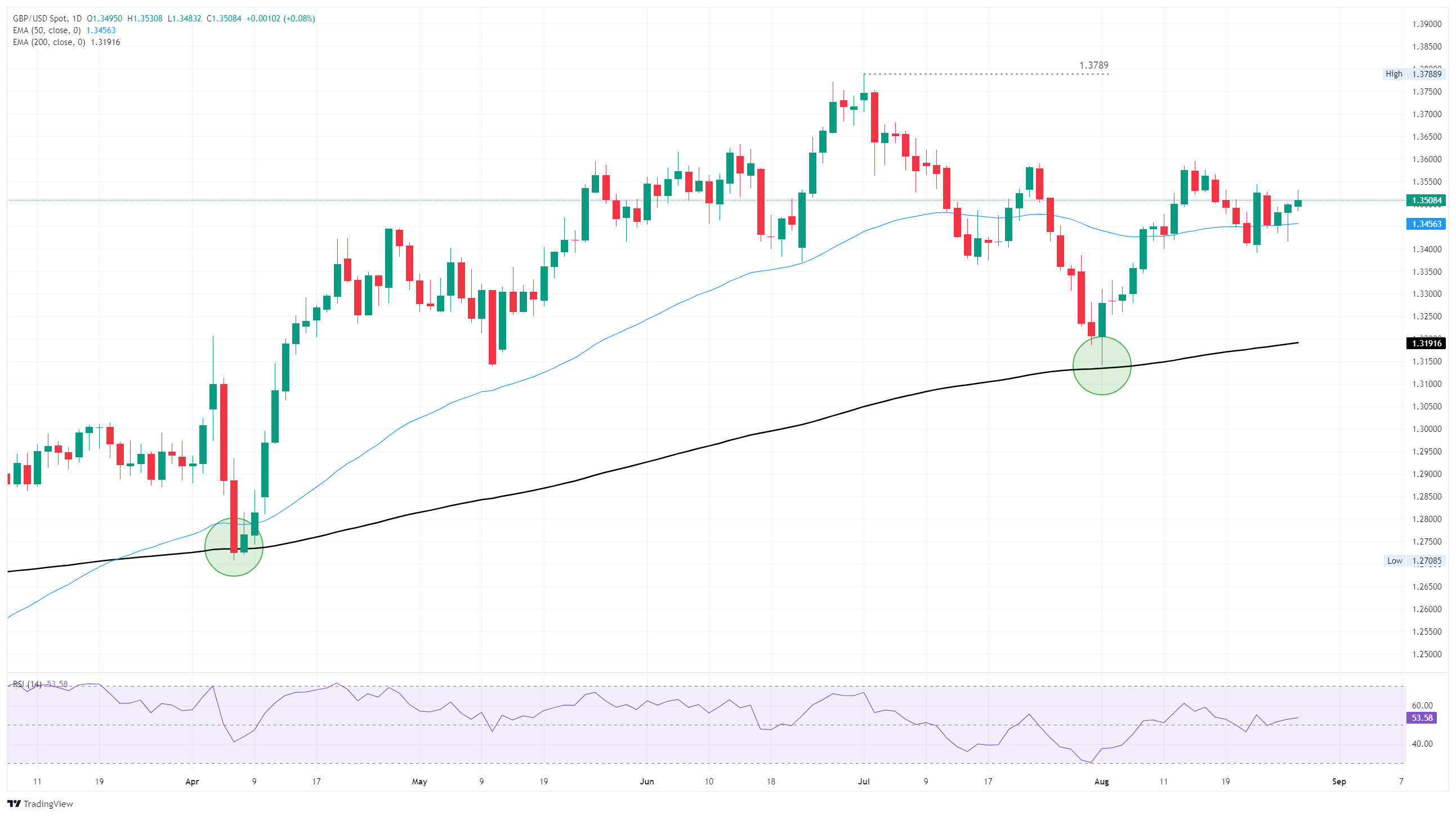GBP/USD extends soft bullish march ahead of looming US inflation data
- GBP/USD chalked in a third straight gain on Thursday, recovering 1.3500.
- US PCE inflation lies ahead on Friday, and global markets have fingers crossed for a not-too-hot print.
- Investors need inflation figures to remain under control to buy a Fed rate cut in September.
GBP/USD marched its way into a third consecutive bullish session on Thursday, climbing back over the 1.3500 handle and paring away most of the early-week losses from Monday’s half-percent decline. Cable remains firmly entrenched in recent consolidation, but markets are positioning themselves for an upside reaction after Friday’s upcoming US Personal Consumption Expenditures Price Index (PCE) inflation print.
GBP/USD is tilting into the bullish side after skidding across the 50-day Exponential Moving Average (EMA) near 1.3455 over the past couple of weeks. Cable still remains over 2% down from multi-year highs posted in July, but has climbed 2.8% from four-month lows near 1.3140.
US PCE inflation to dominate markets on Friday
It’s all eyes on the US data docket on Friday. US PCE inflation for the year ended in July is expected to tick upwards to 2.9% YoY, and investors have their fingers crossed that US inflation will remain under control enough for the Federal Reserve (Fed) to be pushed by lagging employment figures into delivering an interest rate cut on September 17. Core annual US PCE inflation has run above the Fed’s 2% inflation target every single month since April 2021, and has functionally made no progress since July of 2024.
GBP/USD daily chart

Pound Sterling FAQs
The Pound Sterling (GBP) is the oldest currency in the world (886 AD) and the official currency of the United Kingdom. It is the fourth most traded unit for foreign exchange (FX) in the world, accounting for 12% of all transactions, averaging $630 billion a day, according to 2022 data. Its key trading pairs are GBP/USD, also known as ‘Cable’, which accounts for 11% of FX, GBP/JPY, or the ‘Dragon’ as it is known by traders (3%), and EUR/GBP (2%). The Pound Sterling is issued by the Bank of England (BoE).
The single most important factor influencing the value of the Pound Sterling is monetary policy decided by the Bank of England. The BoE bases its decisions on whether it has achieved its primary goal of “price stability” – a steady inflation rate of around 2%. Its primary tool for achieving this is the adjustment of interest rates. When inflation is too high, the BoE will try to rein it in by raising interest rates, making it more expensive for people and businesses to access credit. This is generally positive for GBP, as higher interest rates make the UK a more attractive place for global investors to park their money. When inflation falls too low it is a sign economic growth is slowing. In this scenario, the BoE will consider lowering interest rates to cheapen credit so businesses will borrow more to invest in growth-generating projects.
Data releases gauge the health of the economy and can impact the value of the Pound Sterling. Indicators such as GDP, Manufacturing and Services PMIs, and employment can all influence the direction of the GBP. A strong economy is good for Sterling. Not only does it attract more foreign investment but it may encourage the BoE to put up interest rates, which will directly strengthen GBP. Otherwise, if economic data is weak, the Pound Sterling is likely to fall.
Another significant data release for the Pound Sterling is the Trade Balance. This indicator measures the difference between what a country earns from its exports and what it spends on imports over a given period. If a country produces highly sought-after exports, its currency will benefit purely from the extra demand created from foreign buyers seeking to purchase these goods. Therefore, a positive net Trade Balance strengthens a currency and vice versa for a negative balance.
